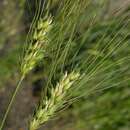Brief Summary
provided by EOL authors
Durum or Macaroni Wheat (
Triticum turgidum durum) is grown far less extensively than
Bread Wheat, accounting for only around 5% of world wheat production (Peng et al. 2011). Durum Wheat has a lower resistance to long, cold long winters, but is more tolerant of drought conditions. In Europe, most Durum Wheat is grown in Spain and Italy, but it is also grown in North Africa, southern Europe, western Asia, Canada, and the United States. On average, the grain has a higher protein content than that of Bread Wheat. Milling separates the grain into
bran,
germ,
semolina (relatively coarse particles of
endosperm), and flour. Pasta such as spaghetti and macaroni is often made from semolina; the flour is used in noodles and other products. Durum Wheat is used to make leavened bread, but its
gluten does not retain carbon dioxide to the same extent as Bread Wheat. Other products of Durum Wheat are
couscous and
bulgur (used in
tabouleh). Domestication of wild Emmer Wheat (
T. turgidum dicoccoides) yielded domesticated Emmer Wheat (
T. turgidum dicoccum), from which "free-threshing" (hull-free) tetraploid wheat such as Durum Wheat (
T. turgidum durum) evolved (Dvorak et al. 2012). (For more on the evolution and domestication of wheat, see
Triticum.) (Vaughan and Geissler 1997; Petrova 2005)
Brief Summary
provided by EOL authors
Triticum durum, durum wheat, is an annual grass in the Poaceae (grass family) native to the Mediterranean region and southwest Asia, which is one of several species of cultivated wheat, now grown in temperate climates worldwide for its cereal grain, which is one of the top two cereal crops grown in the world for human consumption, along with rice (Oryza sativa). (Corn, Zea mays, is grown in larger amounts than rice or wheat, but a significant portion of it is used for livestock feed and biofuel, rather than human food). Wheat is one of the most ancient of domesticated crops, with archaeological evidence of the cultivation of various species in the Fertile Crescent dating back to 9,600 B.C. The various species have been developed into thousands of cultivars (over 25,000, by one estimate) that differ in chromosome number from the primitive diploid types, with 7 pairs of chromosomes, to hybrid allopolyploids, with 14, 21, and 28 chromosome pairs. Durum wheat was developed from wild emmer or kamut (T. turgidum), and has larger, harder grains and a higher protein content and lower gluten content that bread wheat (T. aestivum varieties). Durum wheat varieties are hardy and drought-resistant, often grown in dry regions, and are mostly planted in the spring--in contrast to many bread wheat varieties, known as winter wheat because they are planted in the fall and allowed to overwinter. Wheat is high in carbohydrates, protein (although lacking several essential amino acids), and vitamins B and E (if the grain is left whole); durum wheat is slightly lower than bread wheat in nutrient content. Because of its low gluten content, durum wheat is not used for bread and baked goods, but is wheat used in pasta, semolina (cream of wheat), the Middle Eastern bulgar (wheat that has been boiled, dried, and cracked, and is then prepared like rice and used similarly or prepared into salads such as tabouleh), and North African couscous, which is actually small pellets of pasta. The FAO estimates that global commercial production of all types of wheat was 650.9 million metric tons in 2010, harvested from 217.0 million hectares; it is grown on around 4% of the planet’s agricultural land. Leading producers were China, India, the U.S., the Russian Federation, and France. Within the U.S., the states that were leading producers include Kansas, Montana, North Dakota, South Dakota, Idaho, and Washington. (Bailey et al. 1976, FAOSTAT 2012, Flora of China 2006, Hedrick 1919, USDA 2012, van Wyk 2005.)
Triticum aethiopicum: Brief Summary
provided by wikipedia EN
Triticum aethiopicum, commonly known as Ethiopian wheat, is a variety of wheat closely related to Triticum durum. Ethiopia is considered as a center of origin and diversity for many crop species including tetraploids wheat species. Triticum aethiopiacum is one of the tetraploid wheat grown in Ethiopia.
- license
- cc-by-sa-3.0
- copyright
- Wikipedia authors and editors

